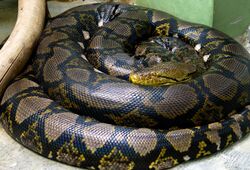Biology:Malayopython
| Malayopython Temporal range: Pleistocene to recent
| |
|---|---|

| |
| Reticulated python (Malayopython reticulatus) | |
| Scientific classification | |
| Domain: | Eukaryota |
| Kingdom: | Animalia |
| Phylum: | Chordata |
| Class: | Reptilia |
| Order: | Squamata |
| Suborder: | Serpentes |
| Family: | Pythonidae |
| Genus: | Malayopython Reynolds et al., 2014 |
Malayopython is a genus of constricting snakes in the family Pythonidae. The genus is native to India and Southeast Asia. It contains two species, both of which were previously classified within the genus Python. However, multiple studies recovered these species as distinct. Known as the "reticulatus clade", it was eventually found to be a sister lineage to a lineage giving rise to the Indo-Australian pythons rather than the genus Python.[1][2]
Taxonomy
In 1975, American herpetologist Samuel Booker McDowell divided the genus Python into a "molurus group" and "reticulatus group" on the basis of differences in supralabial pits (shallow diagonal slits in the latter, square or triangular in the former) and infralabial pits (shallow and not in a groove in the former, in a groove in the latter), as well as differences in the ectopterygoid and hemipenis. He added New Guinea members of Liasis and Morelia to the reticulatus group.[3] American zoologist Arnold G. Kluge performed a cladistics analysis on morphological characters and recovered a reticulatus lineage as a sister to the genus Python; hence not requiring a new generic name in 1993.[4] In a 2004 genetics study using cytochrome b DNA, Robin Lawson and colleagues recovered the reticulated python as a sister to the Australo-Papuan pythons, rather than Python molurus and its relatives.[5]
Raymond Hoser erected the genus Broghammerus for the reticulated python in 2004, naming it after German snake expert Stefan Broghammer, on the basis of dorsal patterns distinct from those of the genus Python, and a dark mid-dorsal line from the rear to the front of the head, and red or orange (rather than brown) iris colour.[6] In 2008, Lesley Rawlings and colleagues reanalysed Kruge's morphological data and combined them with genetic material, and found the reticulated clade to be an offshoot of the Australo-Papuan lineage, as well. They adopted and redefined the genus name Broghammerus.[7] Reynolds and colleagues also confirmed the clade's place as a sister to the Australo-Papuan pythons and coined the name Malayopython, stating that the name Broghammerus was "invalid" due to it being "non-peer reviewed writing that included no formal data or analyses".[8] Reynolds and colleagues cite Kaiser and colleagues who state that, pending "suitable action" from the International Commission on Zoological Nomenclature (ICZN), the name Python should be used in preference of Broghammerus.[9] In 2021, the ICZN reported that it found no basis under the provisions of the Code for regarding [Hoser's journal] as being "unpublished" (i.e. invalid).[10]
Species
| Species | Image | IUCN Red List and geographic range |
|---|---|---|

|
LC | |

|
VU Indonesia on the Lesser Sunda Islands of Flores, Lombien and Timor |
References
- ↑ Figueroa, A.; McKelvy, A. D.; Grismer, L. L.; Bell, C. D.; Lailvaux, S. P. (2016). "A species-level phylogeny of extant snakes with description of a new colubrid subfamily and genus". PLOS ONE 11 (9): e0161070. doi:10.1371/journal.pone.0161070. ISBN 9780643106741. PMID 27603205. Bibcode: 2016PLoSO..1161070F.
- ↑ Barker, D. G.; Barker, T. M.; David, M. A.; Schuett, G. W. (2015). "A review of the systematics and taxonomy of Pythonidae: an ancient serpent lineage". Zoological Journal of the Linnean Society 175: 1–19. doi:10.1111/zoj.12267. https://academic.oup.com/zoolinnean/article-pdf/175/1/1/16876780/zoj12267.pdf.
- ↑ McDowell, S. B. (1975). "A Catalogue of the Snakes of New Guinea and the Solomons, with Special Reference to Those in the Bernice P. Bishop Museum. Part II. Anilioidea and Pythoninae". Journal of Herpetology 9 (1): 1–79. doi:10.2307/1562691.
- ↑ Kluge, A. G. (1993). "Aspidites and the phylogeny of pythonine snakes". Records of the Australian Museum (Supplement 19): 1–77.
- ↑ Lawson, R.; Slowinski, J. B.; Burbrink, F. T. (2004). "A molecular approach to discerning the phylogenetic placement of the enigmatic snake Xenophidion schaeferi among the Alethinophidia". Journal of Zoology 263 (3): 285–294. doi:10.1017/S0952836904005278.
- ↑ Hoser, R. (2004). "A Reclassification of the Pythoninae Including the Descriptions of Two New Genera, Two New Species, and Nine New Subspecies. Part II". Crocodilian - Journal of the Victorian Association of Amateur Herpetologists 4 (4): 21–40. http://www.smuggled.com/pytrev2.htm.
- ↑ Rawlings, L. H.; Rabosky, D. L.; Donnellan, S.C.; Hutchinson, M. N. (2008). "Python phylogenetics: inference from morphology and mitochondrial DNA". Biological Journal of the Linnean Society 93 (3): 603–619. doi:10.1111/j.1095-8312.2007.00904.x. http://www.reticulatedpython.info/me/papers/Rawlings%20et%20al%202008.pdf.
- ↑ Reynolds, R. G., Niemiller, M. L., Revell, L. J. (2014). "Toward a tree-of-life for the boas and pythons: multilocus species-level phylogeny with unprecedented taxon sampling". Molecular Phylogenetics and Evolution 71: 201–213. doi:10.1016/j.ympev.2013.11.011. PMID 24315866.
- ↑ Kaiser, H., Crother, B.I., Kelly, C.M., Luiselli, L., O'Shea, M., Ota, H., Passos, P., Schleip, W.D. and Wüster, W., 2013. Best practices: in the 21st century, taxonomic decisions in herpetology are acceptable only when supported by a body of evidence and published via peer-review.
- ↑ ICZN. 2021. Opinion 2468 (Case 3601) - Spracklandus Hoser, 2009 (Reptilia, Serpentes, Elapidae) and Australasian Journal of Herpetology issues 1-24: confirmation of availability declined; Appendix A (Code of Ethics): not adopted as a formal criterion for ruling on cases. The Bulletin of Zoological Nomenclature 78:42–45.
- ↑ Stuart, B.; Thy, N.; Chan-Ard, T.; Nguyen, T. Q.; Grismer, L.; Auliya, M.; Das, I.; Wogan, G. (2018). "Python reticulatus". IUCN Red List of Threatened Species (IUCN) 2018: e.T183151A1730027. doi:10.2305/IUCN.UK.2018-2.RLTS.T183151A1730027.en. https://www.iucnredlist.org/species/183151/1730027.
Wikidata ☰ Q20052394 entry
 |

